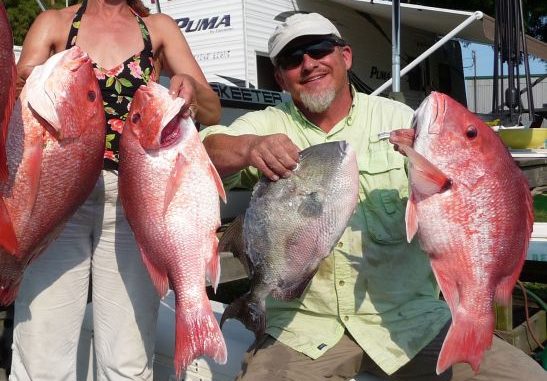
Lafayette angler’s preparedness key to successful outcome
Kenny Begneaud never dreamed that the minor repair he made to the cigarette lighter plug on his 24-foot Skeeter would play a key role in possibly saving his life.
But when he and his wife ran into the buzz saw of an unexpected storm on a snapper trip last June south of Dularge, that plug turned out to be a key factor in the couple’s survival.
Begneaud, 62, a Northwestern Mutual Financial representative in Lafayette, and his wife, Donna, had intended to make a red snapper trip offshore last June 2 out of Pelican Pass, but decided to head to The Pickets instead when they were greeted that morning with a few storms on the horizon.
“We were supposed to go offshore snapper fishing but when we got to the coast there were some thunderstorms and I told my wife, ‘No, we’ll just trout fish,'” he said. “And we fished until about 9 that morning.
“My boat limit for trout is 30 fish, because that’s all I want to clean.”
With all the trout he could handle on board the “Mutual Fun” and the Gulf now smooth as silk, Begneaud decided to head to one of his favorite red snapper rigs at Ship Shoal 154, about 33 miles away.
“The Gulf was like a mirror – glass-flat clam. There were no thunderstorms, no clouds, no nothing,” Begneaud said. “It was like the ideal perfect conditions.
“Or so we thought.”
In less than an hour they arrived at the rig, but were greeted with Jack Crevalle up high and bull reds down deep, with zero current, and no snapper either.
“You could literally kill the engines and not tie up to the rig and the boat would have just sat right there,” Begneaud said. “It was that calm.”
Within 20 minutes, though, two small “popcorn” showers bubbled up to the couple’s east and west, and Donna doesn’t like the rain, so they decided to head for home in flat calm conditions.
What happened within about five minutes from leaving the rig and heading back north still baffles Begneaud almost a year later.
“It deteriorated so fast it was unreal,” he said. “We weren’t running four or five minutes from that rig when we just hit this wall of wind.
“And there were no clouds, with blue skies.”
Those two popcorn showers intensified and turned into a massive black wall behind Begneaud, who was forced to head slightly northwest to take pairs of 6- to 8-foot flat-fronted waves head-on.
“I’d look behind and it looked so menacing, I had to tell myself not to look back, because when I did, it would make me want to try to go too fast forward,” he said. “I couldn’t panic. I just need to stay the course and do what the boat would take.
“I told my wife we might wind up in Cypremort Point or Pecan Island because she was questioning where we were running when we missed Block 84,” he said. “I was just trying to keep the boat afloat.”
Begneaud had never encountered waves so steep, with walls of water literally pouring into the boat, shredding his bimini top, ripping off rod racks and destroying his trolling motor.
The onslaught continued for an hour, and Begneaud wondered if they would survive.
“The boat would go up and drop, and when it would hit, it was so violent – that’s all I could think about: how violent everything was,” he said. “ Everything is going everywhere. The boat would drop down and hit and throw you to the floor. As soon as it hit, the next wave is taking the boat straight up again.
“In the first hour there were four times I thought the boat was going to go over backwards, and that’s what scared the hell out of me. It goes straight up in the air, and you’re just praying it doesn’t go over, because if it goes over backwards, we’re dead.”
The Skeeter is self-bailing, but was taking on massive amounts of water, and the couple was soon standing knee-deep.
But Begneaud kept an extra bilge pump with a 2-inch discharge hose on board, which was powered by his cigarette lighter plug that he had repaired the day before.
“I credit the bilge pump with saving our lives,” he said. “I think without it, we would have gone down.”
After several more harrowing hours, they eventually made it back to Pelican Pass and finally got to Jug’s landing around 3 p.m.
The boat needed about $3,000 in fiberglass repairs, and that figure doesn’t include the handheld GPS, tackle boxes, VHF radio and iPhone that were lost in the storm.
Begneaud, with 40 years experience in the Gulf, wants everyone to know how quickly conditions changed, and stressed the importance of being ready to handle trouble if it should arise.
“It just shows the importance of being prepared,” he said. “We got caught off guard. The storm wasn’t supposed to get to the coast until later that afternoon or evening.
“But it went from dead flat calm to solid wind and waves in no time. The whole time I’m running north I’m looking at blue skies. It followed me the whole way in and caught up to us when we got to Pelican Pass.”
Lightning was popping all around, but as they made their way to Grand Bayou DuLarge, they were just happy to have arrived safely.
“We were both kind of freaked out,” Begneaud said. “When we got to Pelican Pass, I think we hugged.
“It was like, ‘Okay, we made it.’”


